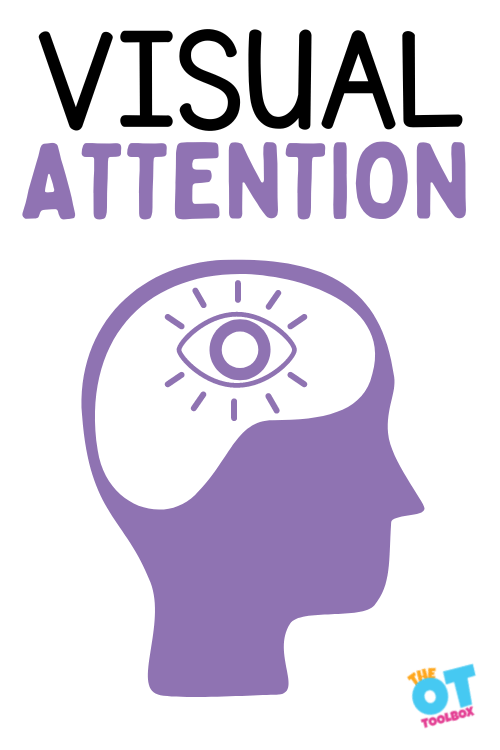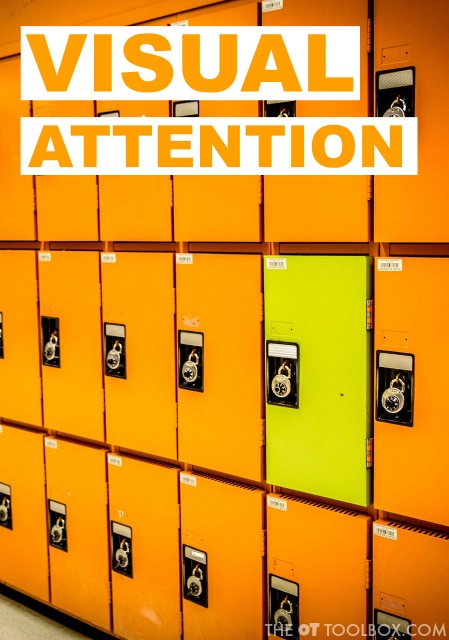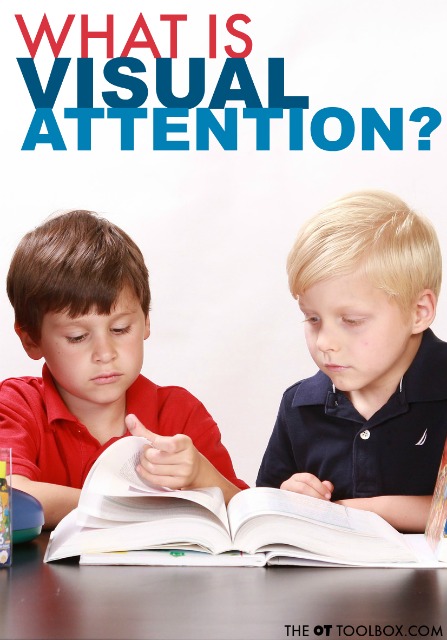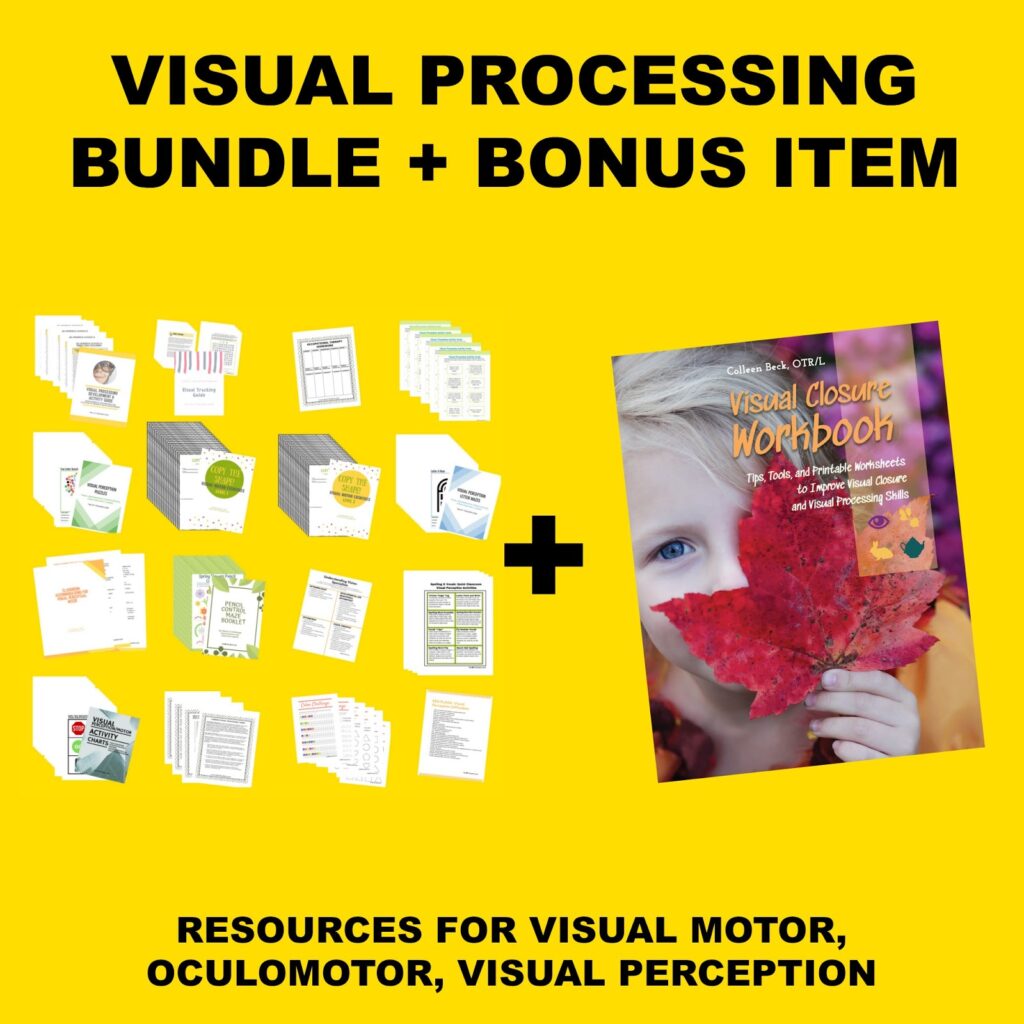Visual attention is a hot topic when it comes to learning! There’s more than meets the eye when it comes to being visually attentive, however. Attention to visual information is an area of visual processing that is more than just focusing on a task or leaning activity. Attention and awareness of visual information is a skill necessary for noticing details, adjusting to patterns, reading, and so much more of the giant visual processing umbrella.
Be sure to read our resource on near point copying as visual attention plays a role in copying written work.

Visual Attention
Read on to discover what is visual attention and how this visual skill impacts so much of what we do.

What is visual attention?
First, it’s important to recognize where visual attention lies in the visual processing umbrella. Visual processing is an aspect that includes the cognitive components, once visual information is received through oculomotor skills and visual acuity.
Attention of visual information is an area of obtaining visual information and communicating that information with the brain. This collection of information requires several eye mobility skills including: voluntary eye movements, visual fixation, smooth pursuits (or visual tracking) and visual scanning.
Additionally, visual perceptual skills are included in the visual processing skill. These skills allow us to discriminate details and fill in “missing pieces” such as partially obscured portions of the form and to use the “mind’s eye” to visualize those aspects.
About Visual Processing…
For more information on visual processing and the aspects that are a part of visual skills (oculomotor skills, visual perception, visual motor integration, etc.) join us in a free 3-day email series, the Visual Processing Lab, as we discuss each aspect of visual processing with a fun, chemo or bio lab theme!
As a related component, the visual input from a picture story sequence can support needs of individuals to work on visual attention.
Visual Attention includes:
1.) Alertness- Defined as “the quality of being alert”, alertness is that watchful and attentive manner of being ready and responsive to visual information. Visual alertness requires focused vision and keenness to a specific object or area in the visual field.
2.) Selective Attention- The ability of noticing and processing specific information while disregarding other, less relevant information describes selective attention. This ability to discern visual information is needed for attending visually to information.
3.) Surrounding Attention- This aspect of attention refers to the surroundings and position in space. An awareness of our body position and the environment happening around us, including distance impacts attention at large.
4.) Mindful Alertness- The ability to be mindful and aware of visual input with a concentrated effort allows attention needed for participating in a visual task. The continuous alertness in a focused state allows us to attend with intention.
5.) Shared Attention- This aspect of visual attention allows us to shift focus between visual input. This can involve filtering of unnecessary information.

Visual Attention and Preattentive Features
If visual memory and attention is depiction of and focusing on specific qualities of a form, then pre-attentive features are basic features of visual information that are automatically noticed by the eyes. These features are easily pulled out of a background or group in a visual display.
Pre-attentive features include:
- Color
- Orientation
- Curvature
- Size
- Motion
- Depth Cues
- Vernier
- Lustre
- Aspects of Shape
Visual Attention and Occupational Therapy
Occupational therapy providers address functional skills in their clients. They help to support every day tasks. Visual attention is one of the underlying components that are required in the visual system and plays a key role in supporting visual processing for performance of everyday activities.
There are several types of visual problems:
1. Visual efficiency- This includes eye movements, eye alignment, and eye focusing. These three abilities relate to functional performance.
Consider these questions related to the attentional mechanisms surrounding visual efficiency:
- Can you be a good reader if you lose your place constantly while reading, because of poor eye movements?
- Can you be a good reader if you are seeing double? Wouldn’t you express visual inattention as a result of double vision?
- Can you be a good reader and learner if the words are moving in and out of focus and as a result you have headaches and eye strain? Wouldn’t these hardships signal the eyes to close one to shutdown, thus losing visual attention to the stimulus of the reading task?
- Wouldn’t visual efficiency problems impact your ability to think with reasoning and impact comprehension as a result?
Looking at these questions, it’s easy to see the attentional effects that visual efficiency has on maintaining attention to visual stimuli.
2. Visual Perception- Visual perceptual skills impact academic performance, and visual attention is one of these. These skills work together to allow for functional vision! Visual perception and attention skills enable the cognitive processes.
- Visual attention
- Visual memory (which requires attention)
- Visual discrimination (which visual attention is a key component in order to discriminate between details)
- Visual closure (in which visual attention is a skill that impacts the mind’s eye in closing a visual image)
- Spatial attention in written work
3. Visual motor integration- The components of visual motor integration includes the integrates the perceptual awareness with the motor output, and attentional skills are a main role. Consider:
- Automaticity of movement
- Rhythm and timing
- Body knowledge and control
- Laterality and directionality
- Reaction time, which is related to the visual attention on a stimulus
- Filtering out irrelevant information
All of these areas listed above impact everyday life!
Visual Attention Tests
There are screening tools that can look at visual attention. These allow the examiner to determine both a focus of attention as well as efficiency and accuracy components. Attention tests won’t give the full picture when used in isolation, but they should be considered as contributing evidence of visual attention challenges.
Some visual attention tests include:
- Basic vision screening- Follow a tongue depressor with a sticker at one end with the eyes, or follow the end of a pen with the eyes. The visual attention screening tool can be used to examine how the eye moves to follow a stimulus across various fields of vision. Another screening task is to ask the participant to scan between tow stimuli held at different sides of their field of vision. Both are also a way to see the attentional capacity to follow a moving target. Included in this screening is a look at pursuits (eye tracking) and saccades (eye scanning). You’ll find more information in our blog posts on visual tracking and visual scanning.
- Test of Visual Perceptual Skills (TVPS-4)
- Beery-Buktenica Developmental Test of Visual Motor Integration, or the Beery VMI
- Non-standardized screenings using Parquetry blocks (tangrams), block copying tests, and directionality tasks
- Copying materials from a near point and far point
Automaticity in Vision Attention
Automaticity refers to the ability to perform routine activities effortlessly and automatically, or without conscious thought. Every motor task that we do throughout the day required conscious through and effort when it was first learned.
Once we’ve done a task for long enough, it becomes routine and automatic. We can then do other tasks at the same time. You see this when driving a car, for example. When the task of driving become so routine and ingrained that it is automatic, we can do other things at the same time: think about our day, remember a thought, carry on a conversation, change the radio station, etc.
Driving is an extremely complex task that moves to a conscious routine over time!
However, the issue is that we have a sort of blindness when we do other things even during an automatic task. Have you ever driven home from work, only to not recall the drive because you were thinking about other things?
We as humans also challenge ourselves, often unsafely, by thinking we can do other things while performing an automatic task. Think: texting while driving. The results from this is unfortunate.
What is at play with automaticity is the visual attention skill that moves from a conscious effort to an unconscious effort.
Similarly, this ability is present when we read or write.
A proficient reader is able to automatically recognize, recall, and reproduce, or write, letters and numbers without conscious effort to identify each letter and number form.
This attention to detail has become ingrained and automatic.
When we see challenges with reading proficiency, comprehension, speed, and overall the student who is struggling academically, the automaticity may be missing. The visual scene is incomplete without the automatic integration of visual attention.
Visual Attention Activities
Visual challenges with spatial skills, omitting materials in reading or writing, and other functional considerations can mean working on visual attention can help. Attention tasks like the ones below can support this skill.
The goal for using these visual attention activities is to have comfortable, efficient, and accurate vision at various distances through the function of play and learning. We want to see eye alignment, eye focusing, and eye movements, all operating at an automatic and reflexive level, or without conscious effort.
- Tangram activities
- Laterality or directionality activities
- Letter tracking in word searches
- Brock string
- Bead stringing sequences
- Directional jumps
- Mazes
- Code deciphering activities
- Dots game
- Sorting items (beads, buttons, etc.)
- Hidden pictures activities
- I Spy
- What’s missing activities
- Spot it game
- Sequencing activities
For the individual with cognitive impairments such as following a stroke or other impairment in which visual inattention is present, some strategies can include:
- Eye patching
- Dynamic stimuli (flashing lights)
- Activities to activate orientation and overall attention
- Verbal cueing
- Auditory cuing (bell, finger tapping, snapping, etc.)
- Tactile cuing to engage the participant to look at the unattended side
- Mirror therapy
Using an adaptive approach to visual inattention is important to foster functional participation, independence, and safety. These strategies can include:
- Compensation strategies
- Incorporate the patient’s awareness
- Place necessary items within the patient’s field of vision
How to work on Visual Attention
For more information and specific activities that can address visual attententiveness in fun and meaningful ways, grab the Visual Processing Bundle. In it, you will find 17 digital products, e-books, workbooks, and guides to addressing various aspects of visual processing. The bundle is valued at over $97 dollars for these products, and includes over 235 pages of tools, activities, resources, information, and strategies to address visual processing needs.
For one week, the visual processing bundle is on sale at $29.99. Grab the Visual Processing Bundle HERE.
References:
Wolfe J. Visual attention. In: De Valois KK, editor. Seeing. 2nd ed. San Diego, CA:
Academic Press; 2000. p. 335-386.

Colleen Beck, OTR/L has been an occupational therapist since 2000, working in school-based, hand therapy, outpatient peds, EI, and SNF. Colleen created The OT Toolbox to inspire therapists, teachers, and parents with easy and fun tools to help children thrive. Read her story about going from an OT making $3/hour (after paying for kids’ childcare) to a full-time OT resource creator for millions of readers. Want to collaborate? Send an email to contact@theottoolbox.com.







